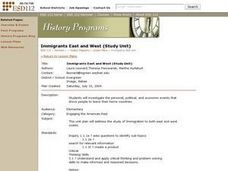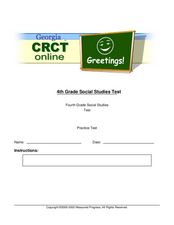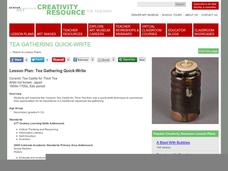Curated OER
Furniture at Blakesley Hall
In this Blakesley Hall activity, students read about the furniture at Blakesley Hall in Yardley. This is all furniture from the 1600s and drawing are included with the descriptions.
Curated OER
Caught Between Worlds: Frontier Life as Reflected in Captivity Narratives
Students analyze captivity narratives written between the 1600's and 1800's. In this narrative lesson, students think critically about the interaction between Native peoples and the settlers to understand the cultural beliefs held by...
Curated OER
Family Life
Students investigate the lives of families in two different centuries. They compare the 1600's to the 1800's. Students write an essay about the differences and how they developed in history. Special attention is paid to the external...
Curated OER
VS.3e
Third graders explore, examine and identify the importance of the arrival of Africans and women to the Jamestown settlement. They review the groups of people in Virginia during the early 1600s and explain how having a government brought...
Curated OER
Networking at Early James Fort
Pupils examine the impact of global trade on regional civilizations of the world after 1500. They research and analyze images of pottery excavated at Jamestown, and create a poster that presents information about world trade networks in...
Curated OER
Immigrants East and West
Young scholars investigate the personal, political and economic events that drove people to leave their home countries. They research Chinese migrations in the 1800s and the English migrations in the 1600s. They create an identity...
Curated OER
The Wooden 0
In this "The Wooden O" instructional activity, students read about the first public theatres in London and answer discussion questions about attending a play during the 1500-1600's. Students then create a poster of the Globe theatre and...
Curated OER
The British Empire – Where the Sun Never Set
Students read an article on the British Empire. In this ESL lesson, students explore the British Empire from the 1600's, then work in small groups to complete several activities that reinforce the information learned in the reading.
Curated OER
The Chesapeake Bay in Captain John Smith's Time
When Captain John Smith visited the Chesapeake Bay in the summer of 1608, what types of animals and habitats did he encounter? Your young historians will analyze primary source documents to answer this question, as well as compare the...
American Museum of Natural History
Rising CO2! What Can We Do?
It is colorless and scentless, but it makes a large impact on the environment. Learners explore carbon dioxide emissions and what they mean for the environment using an interactive graph. They review changes over time and how they impact...
Curated OER
The Restoration Colonies
Explore the earliest American cities in this presentation, which details the demographics, geography, and characteristics of New York, Pennsylvania, and the Carolinas, among others. These slides help to fill in the gap between the...
Curated OER
Book: The Northern Colonies: Quest for Freedom
Students, after reading Chapter 1 in the book, "The Northern Colonies: Quest for Freedom," assess the diseases that killed Native Americans as well as the causes for the spread of disease during this time period. They contemplate medical...
Curated OER
4th Grade Social Studies Quiz
In this social studies worksheet, 4th graders complete multiple choice questions about government, wars, natural resources, and more. Students complete 30 questions.
Curated OER
Mannerism (1520-1600)
Young artists are immersed into the tranformative world of Manneristic Art and Architecture during the Renaissance in this vivid presentation. Providing not only clear and concise charactertistics of Mannerism but examples of many...
Curated OER
The Tragedy of Romeo and Juliet quiz
Review The Tragedy of Romeo and Juliet with this quick quiz. Operating as an overview of the play, use this quiz to prepare readers for a test perhaps. The questions cover various elements from character foils to the plot sequence.
K12 Reader
Indentured Servants
As a reading comprehension exercise, kids read an article about indentured servants and then respond to a series of questions citing evidence from the article to support their responses.
Denver Art Museum
Tea Gathering Quick-Write
Japanese tea gatherings are the inspiration for a great activity. Learners are provided with an image of a tea caddy made for thick tea and asked to describe what they notice and what that might mean. This leads into a larger activity...
Denver Art Museum
Alien Beauty
"Beauty is in the eye of the beholder," is a popular phrase in our society. The lesson here puts the phrase to the test as pupils explore what truly is beautiful through a study of some Japanese folk art. A careful examination of the...
Denver Art Museum
Descriptive Haiku
Even though this is technically an art lesson, haiku poetry is actually the main focus! Learners view photographs of Japanese tea caddies. They list five descriptive words for the caddies, then write haiku poems using the caddies as...
Curated OER
Why Do Governments Exist? Locke, Hobbes, Montesquieu, and Rousseau
Here is a great secondary source reading that includes the primary ideas and philosophies of the famed Enlightenment philosophers: Thomas Hobbes, John Locke, Charles Montesquieu, and Jean-Jacques Rousseau. In additional to discussing...
Berkshire Museum
The Three Life-Giving Sisters: Plant Cultivation and Mohican Innovation
Children gain first-hand experience with Native American agriculture while investigating the life cycle of plants with this engaging experiment. Focusing on what the natives called the Three Sisters - corn, beans, and squash - young...
Sharp School
Newton’s Laws of Motion Project
After a review of all three of Newton's laws, physical scientists complete a choice project. They can create a book in which they collect pictures where the laws of motion are depicted, produce a PowerPoint presentation, or produce a...
NASA
Collecting Electromagnetic Radiation
Astronomy is literally over your head, but this lesson will explain how we study it. Young scientists make telescopes, calculate and compare the light gathering power of lenses, and simulate detection of infared radiation. Materials...
Urbana School District
Magnetism
The compass was first used in 206 B.C., but we didn't discover magnetic poles until 1263 A.D. Presentation begins with the history of magnetism before continuing on to magnetic fields, magnetic forces, electromagnets, currents,...
Other popular searches
- 1600s 1700s History
- England in the 1600s
- 1600s Fur Trading
- 1600's American Folk Dance
- French Culture 1600's
- Education 1600s

























